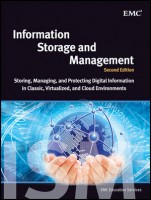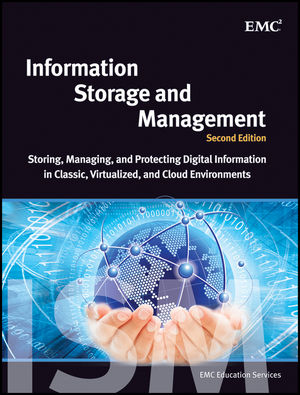 Editors: Somasundaram Gnanasundaram and Alok Shrivastava
Editors: Somasundaram Gnanasundaram and Alok Shrivastava
Publisher: EMC Education Services, John Wiley & Sons – 489 pages
Book Review by: Venkat Subramaniam
This book on storing and managing digital (electronic or computer-based) information is quite extensive in scope. The three principal storage platforms it covers are:
- Traditional or classic storage devices such as internal (within a desktop computer for example) or external hard drives, located outside a computer.
- Virtualized information storage systems: not actual but versions of a hardware platform, operating system, a storage device or network resource.
- Cloud information storage environments. Cloud computing is a general term used to describe Internet services such as social networking services (e.g., Facebook or Twitter), online backup services, and applications that run within a Web browser.
Could computing also includes computer networks that are connected over the Internet for server redundancy or cluster computing purposes.
This volume is a major project headed by two editors who between themselves have more than a half century of experience in information technology.
Somasundaram Gnanasundaram is the director of EMC Education Services. He is the creator of EMC’s open curriculum, which bridges the knowledge gap in the IT industry between information storage and new technologies such as cloud computing.
Alok Shrivastava is a senior director at EMC. He has developed several successful education initiatives, such as the EMC Proven Professional program and the EMC Academic Alliance.
A team of 17 people did editorial, business and marketing work for this book. Chief among them were Carol Long, executive editor; David Mayhew, director of marketing; Richard Swadley and Neil Edde, both vice presidents and executive group publisher and executive publisher, respectively.
Contributors of material for this book also numbered 17; but the reviewers were twice as many, numbering 34. EMC’s Mallik Motilal and Mallesh Gurram contributed graphic work. Motilal created the illustrations for this book and Gurram did the design of its cover.
Much is covered in this book about information storage and management, laid out in its nearly 500 pages with 15 chapters organized in five sections. This book has a detailed table of contents that is 12 pages long. Each chapter contains topics with subtopics. Some of the subtopics also have subtopics within them. All 15 chapters have a summary that the student or casual reader can go to, to get a gist of that particular chapter.
A lot of technical knowledge is required to understand much of the content herein. We will give you an overview of the information so you will get at least a fair idea of what is contained or not contained in this book.
The five sections are named, respectively: storage system; storage networking technologies; backup, archive and replication; cloud computing; and securing and managing storage infrastructure.
The end of the book contains six appendices, followed by a glossary and an index. Appendix A through E are respectively named: Application I/O Characteristics; Parallel SCSI, SAN Design Exercises; Information Availability Exercises; Network technologies for Remote Replication; and Acronyms and Abbreviations.
This book reflects the extensive knowledge of its editors, contributors and reviewers on the many aspects of information storage and management. A lot of research must have also gone into producing it. We applaud the efforts of all those who contributed the material, organized and presented it in this excellent volume.







